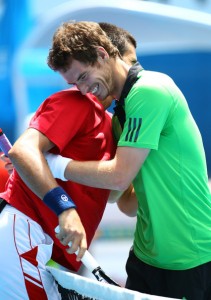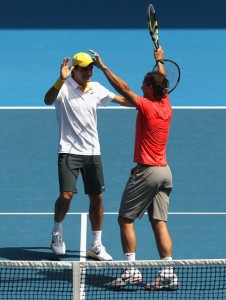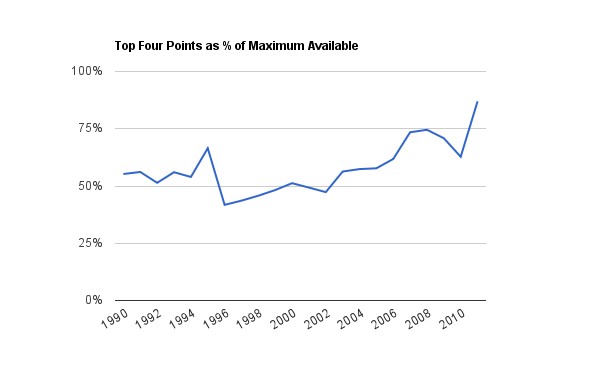There is a case to be made that there is no such thing as the Big Four. Those opposed to the idea correctly point out that Andy Murray has never won a major, and therefore does not merit inclusion in any assembly so august as to feature Roger Federer, Rafael Nadal and Novak Djokovic.  It’s a fair point, and if the criteria for membership in this purely theoretical club included a proven capacity to bag Grand Slams, then the naysayers nays would be hard to gainsay.
It’s a fair point, and if the criteria for membership in this purely theoretical club included a proven capacity to bag Grand Slams, then the naysayers nays would be hard to gainsay.
But insofar as the Big Four means anything at all – and it is largely a mirage – its coherence derives from the capacity to behave as a unit, one that makes less sense without Andy Murray included. The top three win just about everything, it’s true, but the top four not only win everything, but disqualify anyone else from even getting close. So like all imagined communities, it is defined by what it excludes, which in this case is just about everyone. These considerations are particularly relevant right now, having just witnessed a twelve month stretch in which the top four’s dominance is utterly unprecedented, and as we move to the North American hardcourts, a surface upon which none of the four are at their worst, and some are at their best.
In the last 12 months, there have been 14 significant tournaments contested (excluding Davis Cup, a special case). These have comprised four majors, nine Masters 1000 events, and the World Tour Finals. For top players, these comprise the compulsory parts of the season, the events to which they must turn up, or otherwise risk fines, forgo prestige and miss out on the big points hauls. The Big Four turned up at 12 of these 14 events, with Nadal missing the Paris Indoors, and Djokovic opting out of Monte Carlo. In all but one case (Cincinnati 2010), at least three of them made it to semifinals, and in every case, one of the four claimed the event. The only notable tournament that they did not win in the period was the Paris Indoors, which was won by Robin Soderling, ranked No.5. To those who suggest that Djokovic’s domination this season has skewed the figures, consider that had he lost all of his finals, he would merely have lost to Nadal or Murray. The trophy in each case would have remained in the club.
To adjust the perspective slightly: across all of these events, there have been a total of 56 semifinal spots available (14 x 4), and only 16 times did a player not of the top four progress that far.  Of these 16 occasions, the only players to progress past the quarterfinals more than once were David Ferrer (who managed it at the Australian Open and at the Monte Carlo Masters, where Djokovic did not play) and Mardy Fish (semifinals in Miami, and the final in Cincinnati). In other words, in an entire year only 16 semifinal berths have been made available to the rest of the tour, which is astounding in itself, and only becomes more so when we consider that Murray’s abject failure in the American Spring freed up two of those spots (Indian Wells and Miami 2011), whilst another two were opened up when Nadal didn’t play Bercy, and Djokovic didn’t play Monaco.
Of these 16 occasions, the only players to progress past the quarterfinals more than once were David Ferrer (who managed it at the Australian Open and at the Monte Carlo Masters, where Djokovic did not play) and Mardy Fish (semifinals in Miami, and the final in Cincinnati). In other words, in an entire year only 16 semifinal berths have been made available to the rest of the tour, which is astounding in itself, and only becomes more so when we consider that Murray’s abject failure in the American Spring freed up two of those spots (Indian Wells and Miami 2011), whilst another two were opened up when Nadal didn’t play Bercy, and Djokovic didn’t play Monaco.
As a period of domination goes, I suspect it is without precedent. Here are some numbers to back that up. As far as I can make out, these 14 events provide a sum total of 93,300 points (not including qualifying), of which a maximum of 18,500 is available to any single player (that is how many you would receive if you won every event). The theoretical maximum that a group of four players can hold at once is 42,740 (if they all reach at least the semifinals in every event). In the last 12 months, the top four accrued 37,080 points, which is about 86.76% of the theoretical limit. It is hard to overestimate just how impressive this is. In order to demonstrate it, let’s compare it against year end data for the last 21 seasons (back to 1990), with point values adjusted to reflect current ranking points:

The spike in 1995, incidentally, reflected a very strong year for Sampras, Agassi, Muster and Becker, and the subsequent nosedive reflects the precipitous slumps experienced by some of those players. We can also see how profoundly the percentage lifted in 2007, when Djokovic joined the elite. That being said, the current level is over 12% higher than at any other time in the last 20 years.
On that note, the odds are 5/1 that all four will reach the semifinals of the US Open, and 9/4 that they will between them collect the next five majors. Sounds about right.

3 Responses to This Mighty Quartet